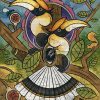| Media | Archival Canvas, Archival Paper |
|---|---|
| Size | 12 x 15 inches, 16 x 20 inches, 24 x 30 inches, 8 x 10 inches |
| Note | * Shipping charges will be extra. |
Hornbill
On a dark July noon, as clouds rumble at the top of their voices, some rain droplets burrow into the nook of a trunk where a half-eaten fig lies dead asleep. The fruit had fallen off the clutches of a Great Hornbill days ago. And suddenly, from the seemingly inert fig, crawls out a ficus, curling around the branches of the host tree. In a matter of months, the ficus branchlets start to strangle the host tree, branch by branch. And as the shape-shifting spell of the hornbill unwinds, stranglers swallow the host tree completely, to become an entirely new, mighty fig tree in just a few years.
My picture of divinity lies in the mythical ways of a forest, which only short-sightedness will identify as ungenerous and bewitching. Because this fruit-bearing tree then lives on to feed the forest for generations. Hundreds of frugivorous birds and animals reap abundance and security from her perennial fruits.
A hundred years later, inside a cavity of this old ficus, a fertile female hornbill has been living in a nest sewn in darkness and depth for forty days now, and the male hornbill has been feeding her figs off the branches nearby. She gives birth to a new generation of kin of her forefathers who had once upon a time sown the seeds of this fig tree, the womb of their future, the womb of a new forest!


